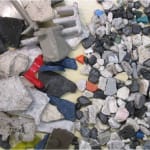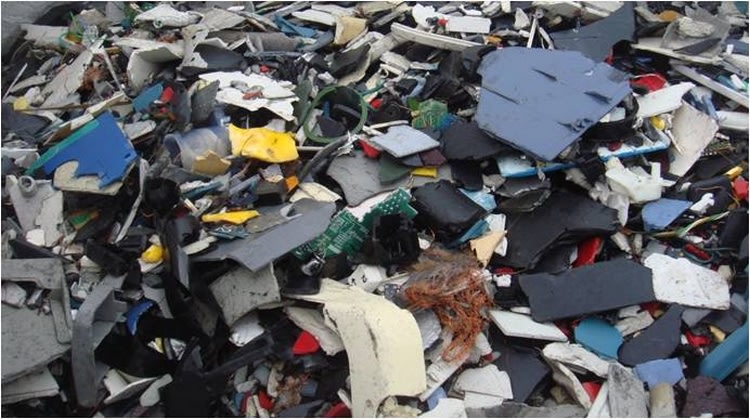
Black plastic parts occur increasingly often in daily life and have therefore become a large challenge for recycling and separation technologies. In its headquarters location in the town of Penzberg in the Federal German state of Bavaria, hamos has been producing already for many years, as one of the worldwide leading suppliers of electrostatic separation technologies, complete recycling lines, with which it is possible to separate black plastics with great success into clean separate fractions according to the types of materials involved.
While the separation technology used by hamos works irrespective of the colour, other separating technologies such as e.g. optical sorting systems are by comparison still very much in their infancy.
Electrical and electronic equipment is made up of many different materials. When recycling this equipment, it is sought above all, and as far as it is possible, to fully recover the metallic fraction (ferrous, non-ferrous and precious metals). The metal fractions are the “object of desire” and various techniques are available for almost complete metal recovery. But electronic waste also contains other recyclable materials such as e.g. plastics such as ABS, PS and other materials. There are still however certain amounts of residual substances which, in some cases have only low or no value at all (dust, glass, etc) and these nevertheless have to be separated from the recyclable materials.
Aside from the “metals” resource, the “plastics” resource should also have to play a large role in recycling. This is however mostly not the case in practice, as recovery of clean plastic fractions from electrical & electronic waste is much more laborious than recycling of the metals. The cause of this is that presently available sorting possibilities can only exploit the entire plastics raw material potential to a limited extent. A large proportion of this material is therefore lost and is then used, for example, to recover thermal energy. The following article is concerned with various possibilities, such as how efficiency of plastics recovery can be raised and how a higher proportion of plastics in electronics waste can be made into valuable, clean plastic fractions.
The granulate material purities achievable with electrostatic separation are very high and sometimes stretch beyond 99.5 %. This means the recyclate is so clean that it can easily be used again to produce high-grade compounds and these in turn can be processed into new technical products. In this way, particularly valuable technical raw materials can be recovered from materials that cannot be processed further as such. Depending on the application, expensive virgin material can be entirely or at least partially replaced by more favourably priced recyclate. Many products can then be produced entirely from recycled plastics. This is an important economic aspect, especially against a background of rising oil and raw material prices, and it also makes an important contribution towards environmental protection through avoidance of waste.
Plastics from electronic waste
By definition, “electrical and electronics scrap” arises from a number of different types of equipment. As mainly no material pre-separation into clear-cut pre-separation according to types of materials is made in recycling companies while processing e.g. small domestic appliances, this mixture of materials ends up in shredding plants. This leads to mixed plastics waste remaining after the metal fraction has been separated out, a material that consists not only of different plastics, but that is furthermore contaminated by dust, wood, pieces off glass, residual metals, elastomers and many other undesired contaminants.
The task of plastics recyclers then consists of production from this complex mixture, corresponding to Photo 1, of re-usable plastics fractions. As experience shows, particularly high demands are placed on purity of the recyclate, as these often compete with virgin materials. On the other hand, there is also a task here of recovering the highest possible proportion of clean plastics, so that as little as possible good material is lost. Plastics recycling is only economic if highest possible material fractions proportions are recovered.

Photo 1. Mixed plastics from electronics scrap after passing through a shredding line and separation of metal fractions
On account of the low amounts of these plastics, recycling only pays off to a limited extent, as the effort required to recover these plastics is sometimes higher than the possible return from them. The largest proportion of plastics in mixed electronics waste consists of PS and ABS, as well as PP. A plastics processing company’s experience has shown these materials make up around 55 % of the input material and that 40 to 50 % of the input material consists of uneconomically recoverable plastic, flame retarded materials and impurities. Work is however ongoing to minimise this fraction with new processes and thereby to raise the return.


